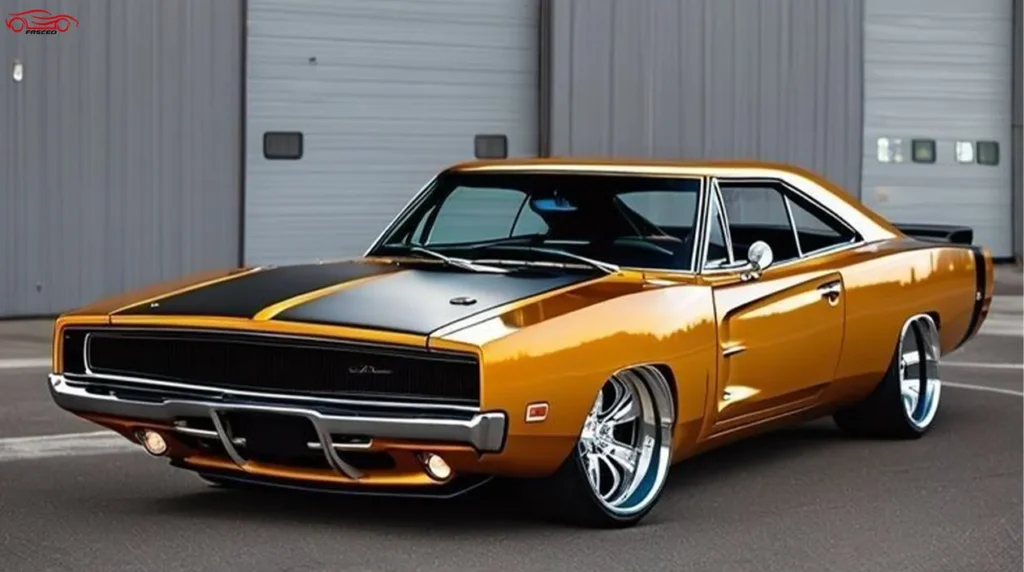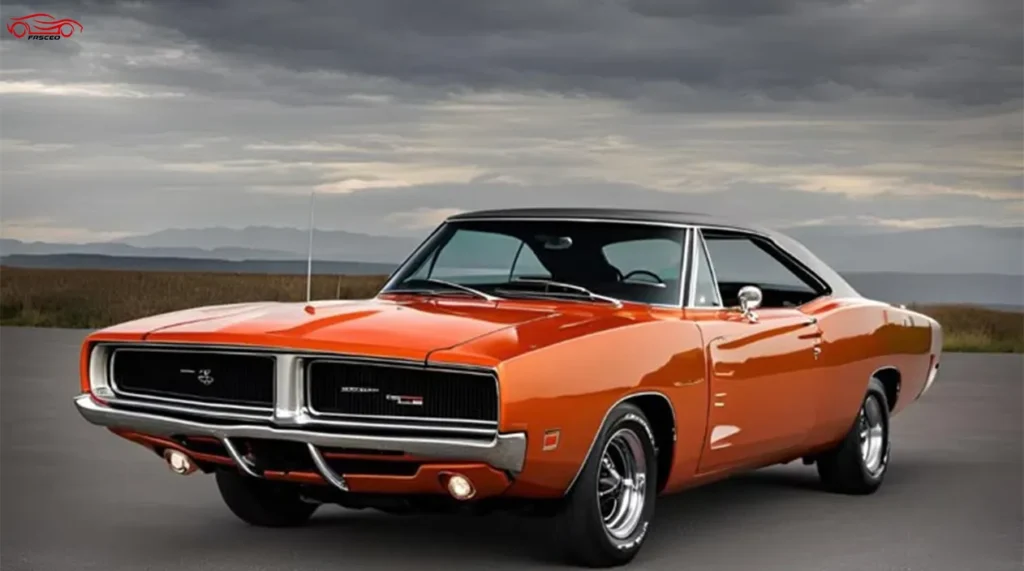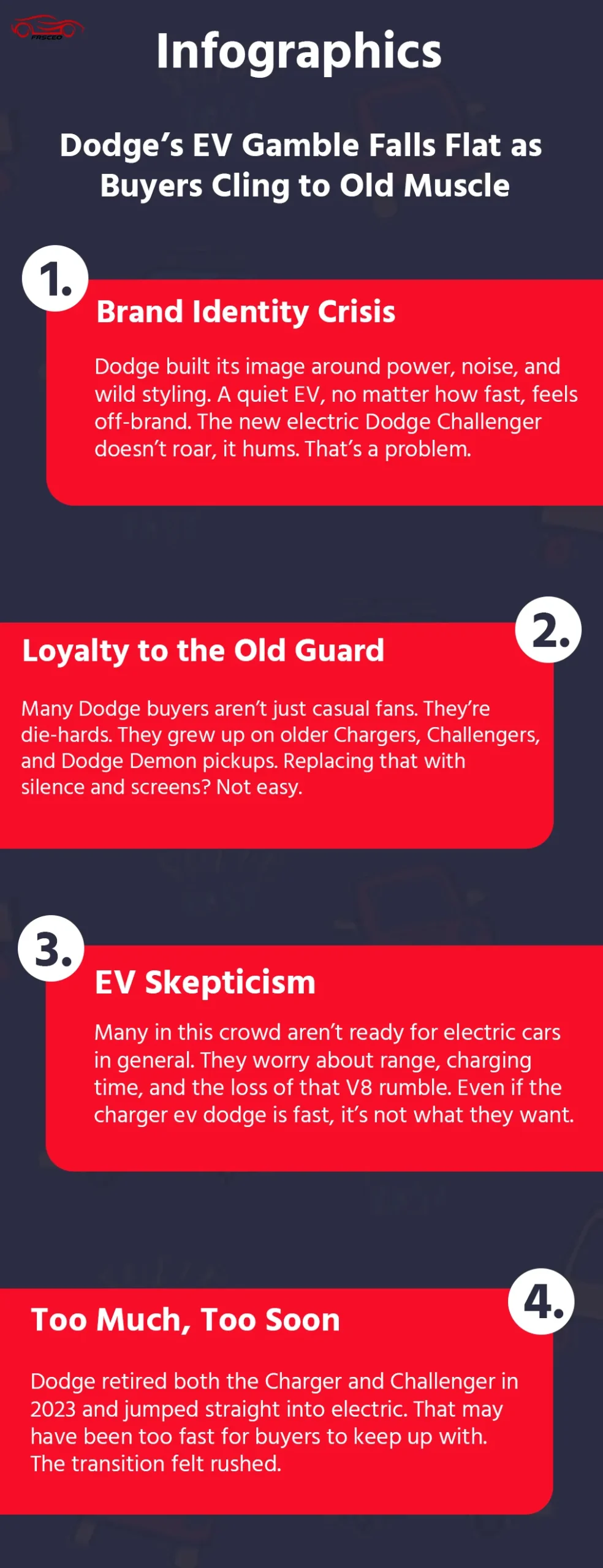The Dodge EV revolution is off to a shaky start. Even with all the buzz around the Charger Daytona electric, it seems fans of old-school power just aren’t ready to let go of it. In fact, in the first quarter of 2025, more people bought older Chargers and Challengers than the brand-new Dodge Daytona Charger EV. That’s a loud message; the muscle car crowd still loves the roar of gas.
Let’s break down why this is happening and what it means for the future of the Dodge EV dream.
Muscle Fans Aren’t Ready for the Switch
Dodge went all-in on electric. They hoped the new electric Challenger and Charger EV Dodge models would spark excitement. But it hasn’t gone as planned.
In early 2025, Dodge sold 1,947 units of the all-electric Charger Daytona. Sounds decent? Not really.
During the same time, they sold 1,052 gas-powered Chargers and 922 Challengers; those cars haven’t even been made since 2023; still, they beat the brand-new Dodge Daytona Charger EV.

That’s 1,974 classic muscle cars sold; more than the new EV. Fans are sticking to what they know.
Visit: Is Car Repair Insurance Worth It? Full Guide
The Inventory Hangover
One reason for this? Simple: the old cars are still out there.
As of April, Dodge dealers had 657 Chargers and 691 Challengers from the 2023 lineup still on their lots. That’s a lot of leftover muscle. For many, it’s their last chance to grab a piece of the old-school power game.
And let’s be honest, who wouldn’t choose a fire-breathing Dodge Demon pickup or a V8 Charger over a silent EV if they’re the same price?
Deep Discounts Can’t Save Sales
It gets worse. The Daytona Electric charger isn’t just struggling with loyalty, it’s getting major discounts, too. Some dealers have slashed prices by up to $21,000. That’s massive for a car that just launched.
One dealership in New York listed a Scat Pack Daytona EV at $61,740, down from $82,175; that’s a clear sign that demand isn’t where Dodge hoped it would be.

Even with the deals, it’s a tough sell. For muscle fans, performance is about more than just numbers, it’s about sound, feel, and tradition and the Dodge electric Challenger just doesn’t deliver the same thrill, yet.
DIscover: Stellantis Car News 2025 | Latest Models, Features and Updates
The Ford Mustang Still Reigns
To put things in perspective, look at Ford. The Mustang, even with a 32% sales dip, still sold over 9,000 units in Q1 2025.
That’s nearly five times more than the Dodge EV offering.
A year ago, Dodge sold over 9,700 Challengers in the first quarter; that’s the kind of volume Dodge is used to in the muscle world. Now, they’re barely touching 2,000 sales with the EV.
What Went Wrong?
Let’s look at the reasons why the 2025 Dodge Challenger electric launch fell flat:

1. Brand Identity Crisis
Dodge built its image around power, noise, and wild styling. A quiet EV, no matter how fast, feels off-brand. The new electric Dodge Challenger doesn’t roar, it hums. That’s a problem.
2. Loyalty to the Old Guard
Many Dodge buyers aren’t just casual fans. They’re die-hards. They grew up on older Chargers, Challengers, and Dodge Demon pickups. Replacing that with silence and screens? Not easy.
3. EV Skepticism
Many in this crowd aren’t ready for electric cars in general. They worry about range, charging time, and the loss of that V8 rumble. Even if the charger ev dodge is fast, it’s not what they want.
Explore: Donk Cars: Complete Guide To These Bold Rides
4. Too Much, Too Soon
Dodge retired both the Charger and Challenger in 2023 and jumped straight into electric. That may have been too fast for buyers to keep up with. The transition felt rushed.
Sales Drop Hits the Whole Brand
It’s not just the Dodge EV that’s struggling. The whole brand took a hit.
In Q1 2025, Dodge sold only 21,731 vehicles, down 49% from 42,948 the year before. The Hornet SUV dropped 45%. Even the Durango, a long-time favorite, fell 9%.
That’s not just a product problem. It’s a brand problem. Something bigger is off at Dodge, and EV struggles are just part of it.
The Muscle Market Still Has Life
Even with these changes, the market for muscle cars isn’t dead. In fact, it’s clear that many fans still crave gas power.
That’s why Dodge is fast-tracking a return to gas, at least partly. New models of the Charger are on the way, including:
- A four-door Daytona
- A twin-turbo inline-six engine
- Possibly a hybrid or low-volt setup
These might hit the sweet spot. Enough innovation to feel modern, but still packed with that classic Dodge punch.
Learn More: Toyota 1958 Land Cruiser: 7 Key Impressions
What’s Next for Dodge?
So, where does Dodge go from here? A few things seem likely:
- They won’t abandon EVs. Dodge still sees a future in electric vehicles. But it may be more gradual now.
- More flexible options. Gas, electric, and hybrid may all exist side-by-side for a while.
- Appealing to both sides. Dodge wants to keep muscle fans and bring in new EV buyers. That’s a tightrope.
It’s not easy to reinvent a brand. Especially one built on rebellion, smoke, and noise. But if Dodge listens to its buyers, it might just find the right path forward.
Check this out: Stellantis Car News 2025 | Latest Models, Features and Updates
Final Thoughts: Can the Dodge EV Find Its Place?
The Dodge EV initiative may be faltering at the moment, but it is far from a lost cause.
Transitioning from decades of gasoline-fueled tradition to electric innovation is no small feat, particularly in a segment as emotionally charged as American muscle cars. The new electric Dodge Challenger and the Dodge Daytona Charger EV undeniably boast impressive specs and bold styling, yet they’ve fallen short of igniting the visceral connection that enthusiasts crave.
Still, this is a pivotal learning moment for Dodge. The 2025 Dodge Challenger electric may not have achieved the breakout success the company envisioned, but it reflects a broader evolution in automotive identity, one that blends performance with sustainability.
To truly resonate with its loyal fan base, Dodge must strike a careful balance between mechanical soul and technological advancement. Winning over the skeptics will require more than just acceleration figures or aggressive marketing; it will demand an EV that feels as thrilling and alive as its combustion predecessors.
Because for muscle car purists, performance isn’t just about speed; it’s about sensation, sound, and spirit. If Dodge can distill those intangible qualities into an electric format, there’s still a path forward. A bright one.
But for now, the message is clear: the faithful remain attached to the past, and the Dodge EV still faces an uphill battle.



